steering VOLVO XC90 TWIN ENGINE HYBRID 2017 Owners Manual
[x] Cancel search | Manufacturer: VOLVO, Model Year: 2017, Model line: XC90 TWIN ENGINE HYBRID, Model: VOLVO XC90 TWIN ENGINE HYBRID 2017Pages: 584, PDF Size: 14.2 MB
Page 6 of 584
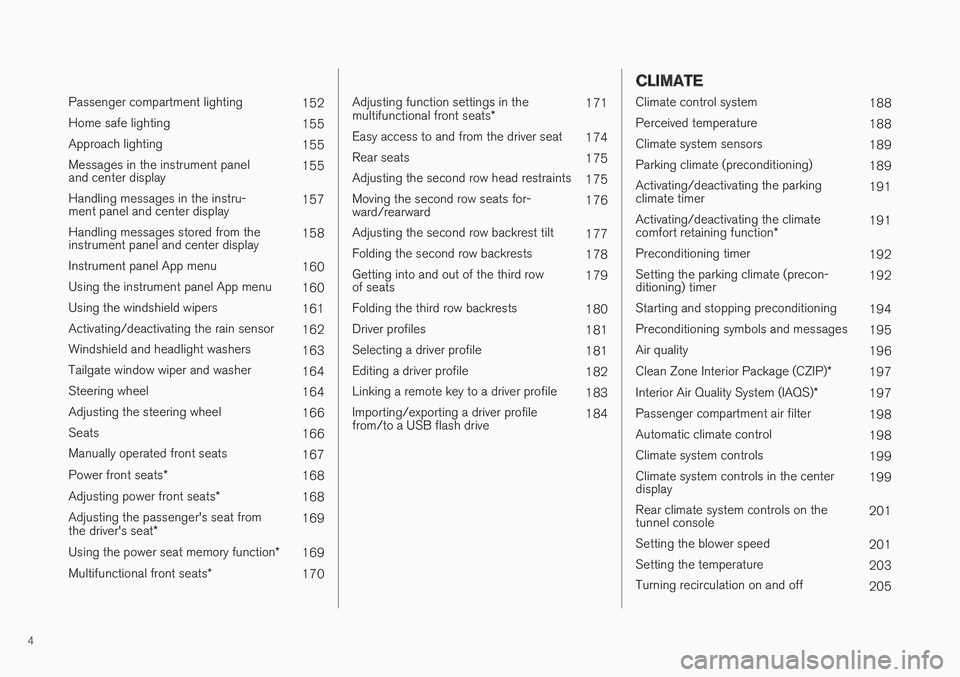
4
Passenger compartment lighting152
Home safe lighting155
Approach lighting155
Messages in the instrument paneland center display155
Handling messages in the instru-ment panel and center display157
Handling messages stored from theinstrument panel and center display158
Instrument panel App menu160
Using the instrument panel App menu160
Using the windshield wipers161
Activating/deactivating the rain sensor162
Windshield and headlight washers163
Tailgate window wiper and washer164
Steering wheel164
Adjusting the steering wheel166
Seats166
Manually operated front seats167
Power front seats*168
Adjusting power front seats*168
Adjusting the passenger's seat fromthe driver's seat*169
Using the power seat memory function*169
Multifunctional front seats*170
Adjusting function settings in themultifunctional front seats*171
Easy access to and from the driver seat174
Rear seats175
Adjusting the second row head restraints175
Moving the second row seats for-ward/rearward176
Adjusting the second row backrest tilt177
Folding the second row backrests178
Getting into and out of the third rowof seats179
Folding the third row backrests180
Driver profiles181
Selecting a driver profile181
Editing a driver profile182
Linking a remote key to a driver profile183
Importing/exporting a driver profilefrom/to a USB flash drive184
CLIMATE
Climate control system188
Perceived temperature188
Climate system sensors189
Parking climate (preconditioning)189
Activating/deactivating the parkingclimate timer191
Activating/deactivating the climatecomfort retaining function*191
Preconditioning timer192
Setting the parking climate (precon-ditioning) timer192
Starting and stopping preconditioning194
Preconditioning symbols and messages195
Air quality196
Clean Zone Interior Package (CZIP)*197
Interior Air Quality System (IAQS)*197
Passenger compartment air filter198
Automatic climate control198
Climate system controls199
Climate system controls in the centerdisplay199
Rear climate system controls on thetunnel console201
Setting the blower speed201
Setting the temperature203
Turning recirculation on and off205
Page 7 of 584
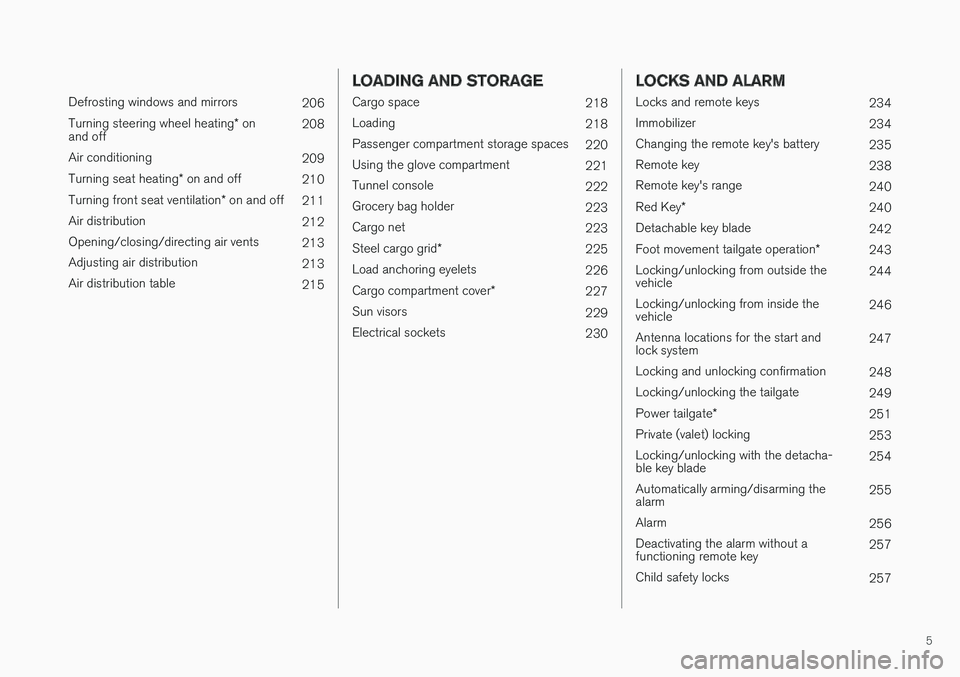
5
Defrosting windows and mirrors206
Turning steering wheel heating* onand off208
Air conditioning209
Turning seat heating* on and off210
Turning front seat ventilation* on and off211
Air distribution212
Opening/closing/directing air vents213
Adjusting air distribution213
Air distribution table215
LOADING AND STORAGE
Cargo space218
Loading218
Passenger compartment storage spaces220
Using the glove compartment221
Tunnel console222
Grocery bag holder223
Cargo net223
Steel cargo grid*225
Load anchoring eyelets226
Cargo compartment cover*227
Sun visors229
Electrical sockets230
LOCKS AND ALARM
Locks and remote keys234
Immobilizer234
Changing the remote key's battery235
Remote key238
Remote key's range240
Red Key*240
Detachable key blade242
Foot movement tailgate operation*243
Locking/unlocking from outside thevehicle244
Locking/unlocking from inside thevehicle246
Antenna locations for the start andlock system247
Locking and unlocking confirmation248
Locking/unlocking the tailgate249
Power tailgate*251
Private (valet) locking253
Locking/unlocking with the detacha-ble key blade254
Automatically arming/disarming thealarm255
Alarm256
Deactivating the alarm without afunctioning remote key257
Child safety locks257
Page 8 of 584
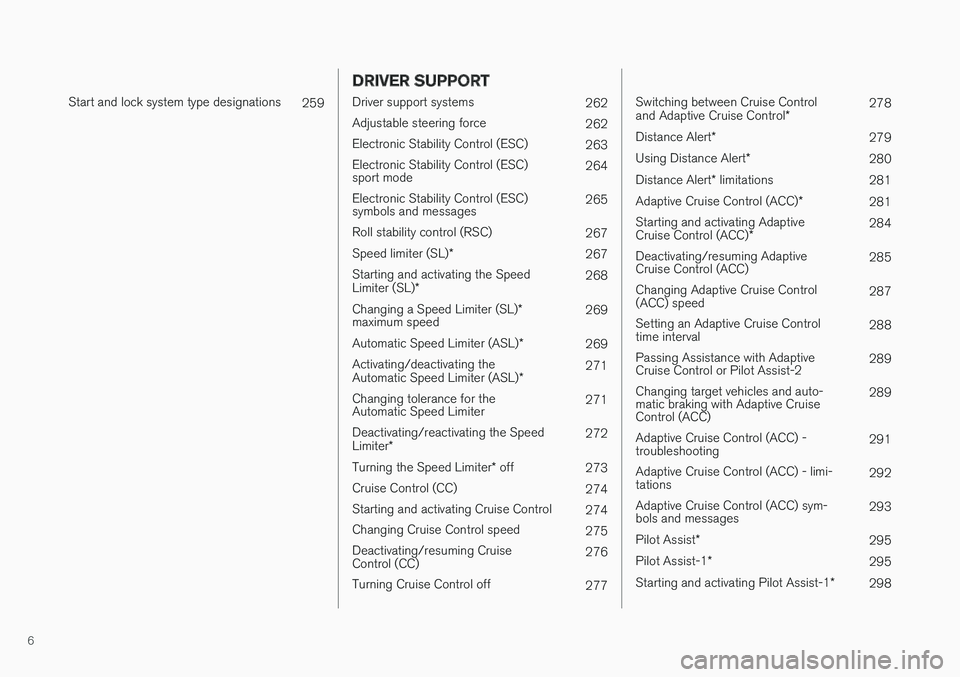
6
Start and lock system type designations259
DRIVER SUPPORT
Driver support systems262
Adjustable steering force262
Electronic Stability Control (ESC)263
Electronic Stability Control (ESC)sport mode264
Electronic Stability Control (ESC)symbols and messages265
Roll stability control (RSC)267
Speed limiter (SL)*267
Starting and activating the SpeedLimiter (SL)*268
Changing a Speed Limiter (SL)*maximum speed269
Automatic Speed Limiter (ASL)*269
Activating/deactivating theAutomatic Speed Limiter (ASL)*271
Changing tolerance for theAutomatic Speed Limiter271
Deactivating/reactivating the SpeedLimiter*272
Turning the Speed Limiter* off273
Cruise Control (CC)274
Starting and activating Cruise Control274
Changing Cruise Control speed275
Deactivating/resuming CruiseControl (CC)276
Turning Cruise Control off277
Switching between Cruise Controland Adaptive Cruise Control*278
Distance Alert*279
Using Distance Alert*280
Distance Alert* limitations281
Adaptive Cruise Control (ACC)*281
Starting and activating AdaptiveCruise Control (ACC)*284
Deactivating/resuming AdaptiveCruise Control (ACC)285
Changing Adaptive Cruise Control(ACC) speed287
Setting an Adaptive Cruise Controltime interval288
Passing Assistance with AdaptiveCruise Control or Pilot Assist-2289
Changing target vehicles and auto-matic braking with Adaptive CruiseControl (ACC)
289
Adaptive Cruise Control (ACC) -troubleshooting291
Adaptive Cruise Control (ACC) - limi-tations292
Adaptive Cruise Control (ACC) sym-bols and messages293
Pilot Assist*295
Pilot Assist-1*295
Starting and activating Pilot Assist-1*298
Page 10 of 584
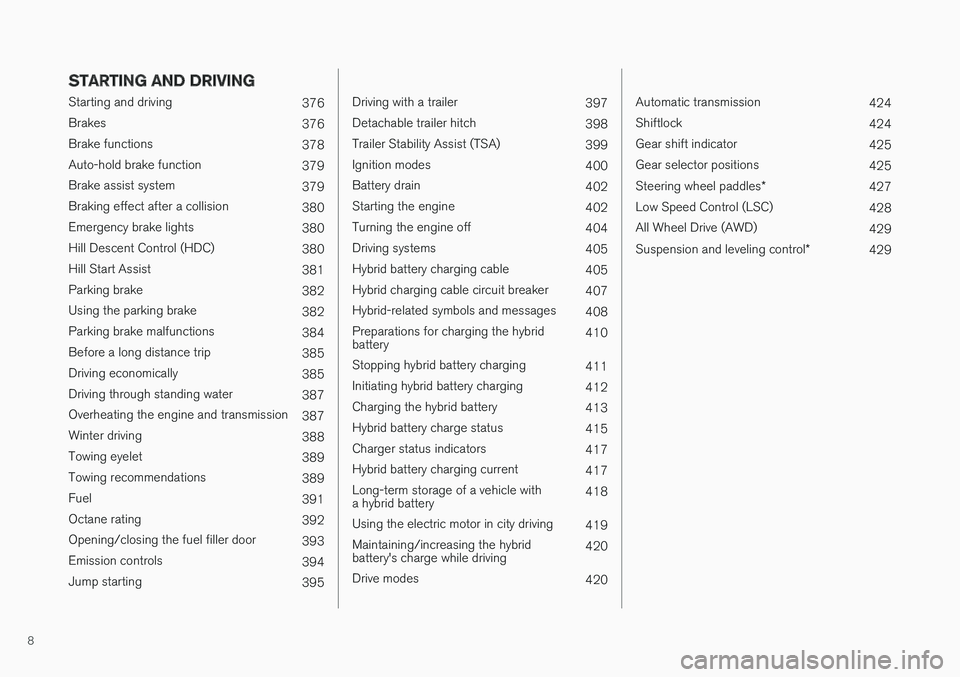
8
STARTING AND DRIVING
Starting and driving376
Brakes376
Brake functions378
Auto-hold brake function379
Brake assist system379
Braking effect after a collision380
Emergency brake lights380
Hill Descent Control (HDC)380
Hill Start Assist381
Parking brake382
Using the parking brake382
Parking brake malfunctions384
Before a long distance trip385
Driving economically385
Driving through standing water387
Overheating the engine and transmission387
Winter driving388
Towing eyelet389
Towing recommendations389
Fuel391
Octane rating392
Opening/closing the fuel filler door393
Emission controls394
Jump starting395
Driving with a trailer397
Detachable trailer hitch398
Trailer Stability Assist (TSA)399
Ignition modes400
Battery drain402
Starting the engine402
Turning the engine off404
Driving systems405
Hybrid battery charging cable405
Hybrid charging cable circuit breaker407
Hybrid-related symbols and messages408
Preparations for charging the hybridbattery410
Stopping hybrid battery charging411
Initiating hybrid battery charging412
Charging the hybrid battery413
Hybrid battery charge status415
Charger status indicators417
Hybrid battery charging current417
Long-term storage of a vehicle witha hybrid battery418
Using the electric motor in city driving419
Maintaining/increasing the hybridbattery's charge while driving420
Drive modes420
Automatic transmission424
Shiftlock424
Gear shift indicator425
Gear selector positions425
Steering wheel paddles*427
Low Speed Control (LSC)428
All Wheel Drive (AWD)429
Suspension and leveling control*429
Page 22 of 584
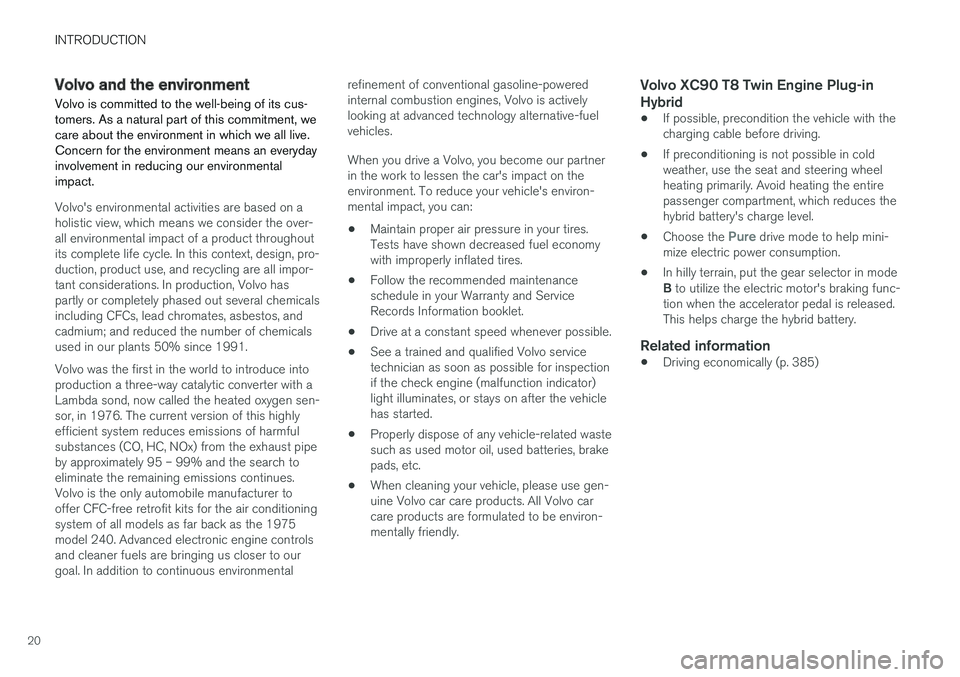
INTRODUCTION
20
Volvo and the environment
Volvo is committed to the well-being of its cus-tomers. As a natural part of this commitment, wecare about the environment in which we all live.Concern for the environment means an everydayinvolvement in reducing our environmentalimpact.
Volvo's environmental activities are based on aholistic view, which means we consider the over-all environmental impact of a product throughoutits complete life cycle. In this context, design, pro-duction, product use, and recycling are all impor-tant considerations. In production, Volvo haspartly or completely phased out several chemicalsincluding CFCs, lead chromates, asbestos, andcadmium; and reduced the number of chemicalsused in our plants 50% since 1991.
Volvo was the first in the world to introduce intoproduction a three-way catalytic converter with aLambda sond, now called the heated oxygen sen-sor, in 1976. The current version of this highlyefficient system reduces emissions of harmfulsubstances (CO, HC, NOx) from the exhaust pipeby approximately 95 – 99% and the search toeliminate the remaining emissions continues.Volvo is the only automobile manufacturer tooffer CFC-free retrofit kits for the air conditioningsystem of all models as far back as the 1975model 240. Advanced electronic engine controlsand cleaner fuels are bringing us closer to ourgoal. In addition to continuous environmental
refinement of conventional gasoline-poweredinternal combustion engines, Volvo is activelylooking at advanced technology alternative-fuelvehicles.
When you drive a Volvo, you become our partnerin the work to lessen the car's impact on theenvironment. To reduce your vehicle's environ-mental impact, you can:
•Maintain proper air pressure in your tires.Tests have shown decreased fuel economywith improperly inflated tires.
•Follow the recommended maintenanceschedule in your Warranty and ServiceRecords Information booklet.
•Drive at a constant speed whenever possible.
•See a trained and qualified Volvo servicetechnician as soon as possible for inspectionif the check engine (malfunction indicator)light illuminates, or stays on after the vehiclehas started.
•Properly dispose of any vehicle-related wastesuch as used motor oil, used batteries, brakepads, etc.
•When cleaning your vehicle, please use gen-uine Volvo car care products. All Volvo carcare products are formulated to be environ-mentally friendly.
Volvo XC90 T8 Twin Engine Plug-in
Hybrid
•If possible, precondition the vehicle with thecharging cable before driving.
•If preconditioning is not possible in coldweather, use the seat and steering wheelheating primarily. Avoid heating the entirepassenger compartment, which reduces thehybrid battery's charge level.
•Choose the Pure drive mode to help mini-mize electric power consumption.
•In hilly terrain, put the gear selector in modeB to utilize the electric motor's braking func-tion when the accelerator pedal is released.This helps charge the hybrid battery.
Related information
•Driving economically (p. 385)
Page 25 of 584
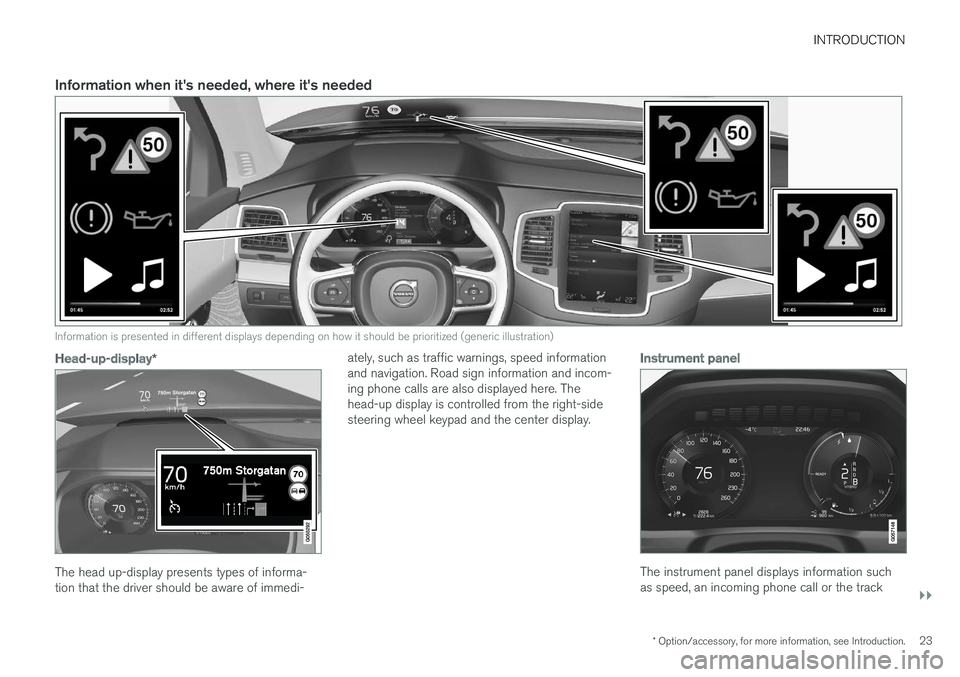
INTRODUCTION
}}
* Option/accessory, for more information, see Introduction.23
Information when it's needed, where it's needed
Information is presented in different displays depending on how it should be prioritized (generic illustration)
Head-up-display *
The head up-display presents types of informa-tion that the driver should be aware of immedi-
ately, such as traffic warnings, speed informationand navigation. Road sign information and incom-ing phone calls are also displayed here. Thehead-up display is controlled from the right-sidesteering wheel keypad and the center display.
Instrument panel
The instrument panel displays information suchas speed, an incoming phone call or the track
Page 26 of 584
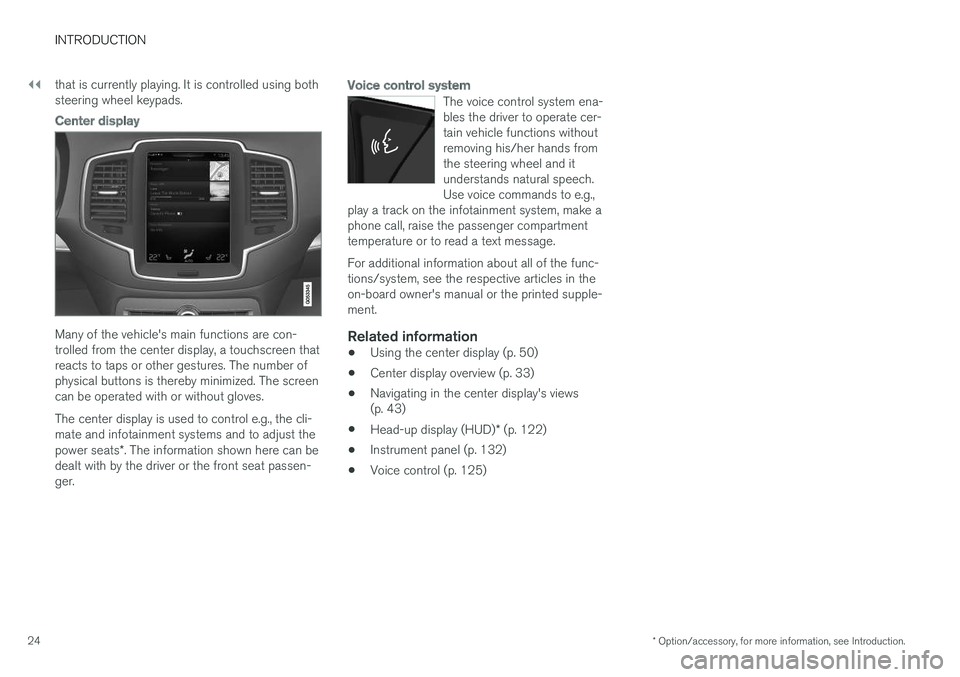
||
INTRODUCTION
* Option/accessory, for more information, see Introduction.24
that is currently playing. It is controlled using bothsteering wheel keypads.
Center display
Many of the vehicle's main functions are con-trolled from the center display, a touchscreen thatreacts to taps or other gestures. The number ofphysical buttons is thereby minimized. The screencan be operated with or without gloves.
The center display is used to control e.g., the cli-mate and infotainment systems and to adjust thepower seats*. The information shown here can bedealt with by the driver or the front seat passen-ger.
Voice control system
The voice control system ena-bles the driver to operate cer-tain vehicle functions withoutremoving his/her hands fromthe steering wheel and itunderstands natural speech.Use voice commands to e.g.,play a track on the infotainment system, make aphone call, raise the passenger compartmenttemperature or to read a text message.
For additional information about all of the func-tions/system, see the respective articles in theon-board owner's manual or the printed supple-ment.
Related information
•Using the center display (p. 50)
•Center display overview (p. 33)
•Navigating in the center display's views(p. 43)
•Head-up display (HUD)* (p. 122)
•Instrument panel (p. 132)
•Voice control (p. 125)
Page 28 of 584
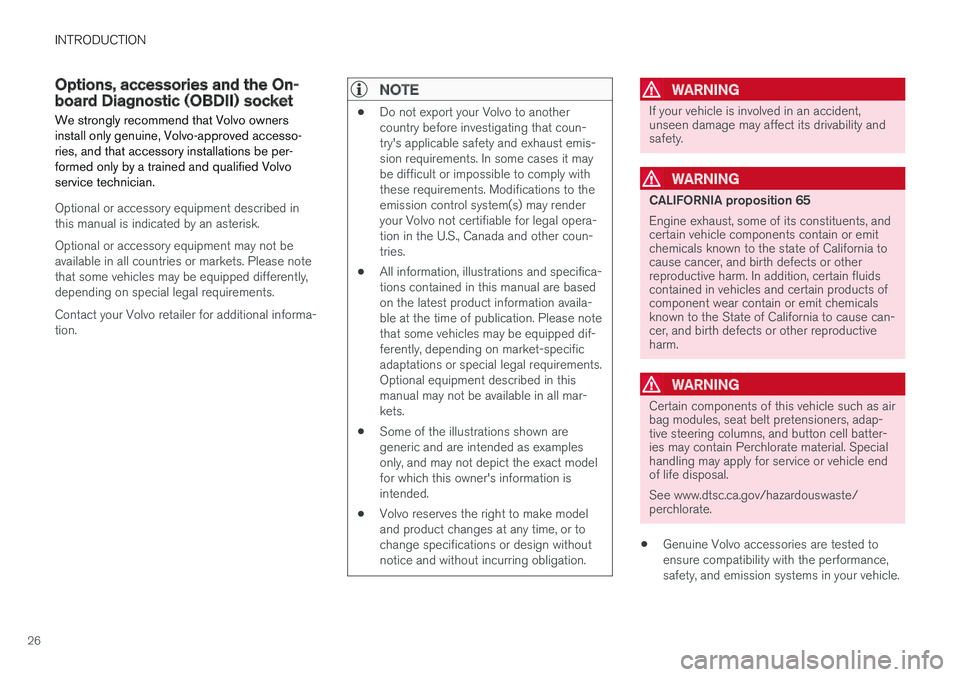
INTRODUCTION
26
Options, accessories and the On-board Diagnostic (OBDII) socket
We strongly recommend that Volvo ownersinstall only genuine, Volvo-approved accesso-ries, and that accessory installations be per-formed only by a trained and qualified Volvoservice technician.
Optional or accessory equipment described inthis manual is indicated by an asterisk.
Optional or accessory equipment may not beavailable in all countries or markets. Please notethat some vehicles may be equipped differently,depending on special legal requirements.
Contact your Volvo retailer for additional informa-tion.
NOTE
•Do not export your Volvo to anothercountry before investigating that coun-try's applicable safety and exhaust emis-sion requirements. In some cases it maybe difficult or impossible to comply withthese requirements. Modifications to theemission control system(s) may renderyour Volvo not certifiable for legal opera-tion in the U.S., Canada and other coun-tries.
•All information, illustrations and specifica-tions contained in this manual are basedon the latest product information availa-ble at the time of publication. Please notethat some vehicles may be equipped dif-ferently, depending on market-specificadaptations or special legal requirements.Optional equipment described in thismanual may not be available in all mar-kets.
•Some of the illustrations shown aregeneric and are intended as examplesonly, and may not depict the exact modelfor which this owner's information isintended.
•Volvo reserves the right to make modeland product changes at any time, or tochange specifications or design withoutnotice and without incurring obligation.
WARNING
If your vehicle is involved in an accident,unseen damage may affect its drivability andsafety.
WARNING
CALIFORNIA proposition 65
Engine exhaust, some of its constituents, andcertain vehicle components contain or emitchemicals known to the state of California tocause cancer, and birth defects or otherreproductive harm. In addition, certain fluidscontained in vehicles and certain products ofcomponent wear contain or emit chemicalsknown to the State of California to cause can-cer, and birth defects or other reproductiveharm.
WARNING
Certain components of this vehicle such as airbag modules, seat belt pretensioners, adap-tive steering columns, and button cell batter-ies may contain Perchlorate material. Specialhandling may apply for service or vehicle endof life disposal.
See www.dtsc.ca.gov/hazardouswaste/perchlorate.
•Genuine Volvo accessories are tested toensure compatibility with the performance,safety, and emission systems in your vehicle.
Page 36 of 584
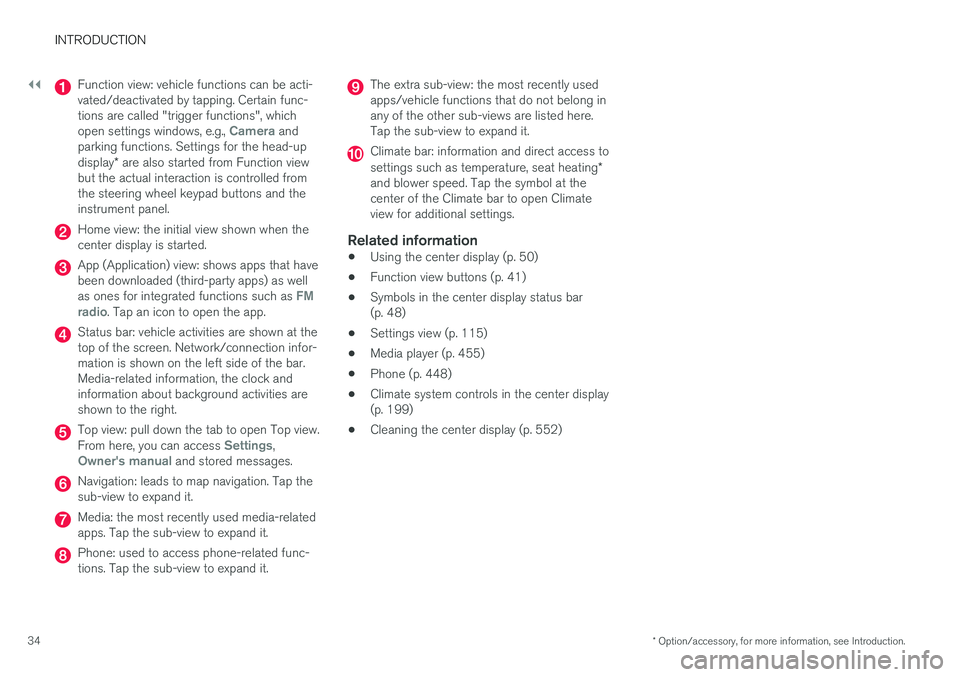
||
INTRODUCTION
* Option/accessory, for more information, see Introduction.34
Function view: vehicle functions can be acti-vated/deactivated by tapping. Certain func-tions are called "trigger functions", whichopen settings windows, e.g., Camera andparking functions. Settings for the head-updisplay* are also started from Function viewbut the actual interaction is controlled fromthe steering wheel keypad buttons and theinstrument panel.
Home view: the initial view shown when thecenter display is started.
App (Application) view: shows apps that havebeen downloaded (third-party apps) as wellas ones for integrated functions such as FMradio. Tap an icon to open the app.
Status bar: vehicle activities are shown at thetop of the screen. Network/connection infor-mation is shown on the left side of the bar.Media-related information, the clock andinformation about background activities areshown to the right.
Top view: pull down the tab to open Top view.From here, you can access Settings,Owner's manual and stored messages.
Navigation: leads to map navigation. Tap thesub-view to expand it.
Media: the most recently used media-relatedapps. Tap the sub-view to expand it.
Phone: used to access phone-related func-tions. Tap the sub-view to expand it.
The extra sub-view: the most recently usedapps/vehicle functions that do not belong inany of the other sub-views are listed here.Tap the sub-view to expand it.
Climate bar: information and direct access tosettings such as temperature, seat heating*and blower speed. Tap the symbol at thecenter of the Climate bar to open Climateview for additional settings.
Related information
•Using the center display (p. 50)
•Function view buttons (p. 41)
•Symbols in the center display status bar(p. 48)
•Settings view (p. 115)
•Media player (p. 455)
•Phone (p. 448)
•Climate system controls in the center display(p. 199)
•Cleaning the center display (p. 552)
Page 66 of 584
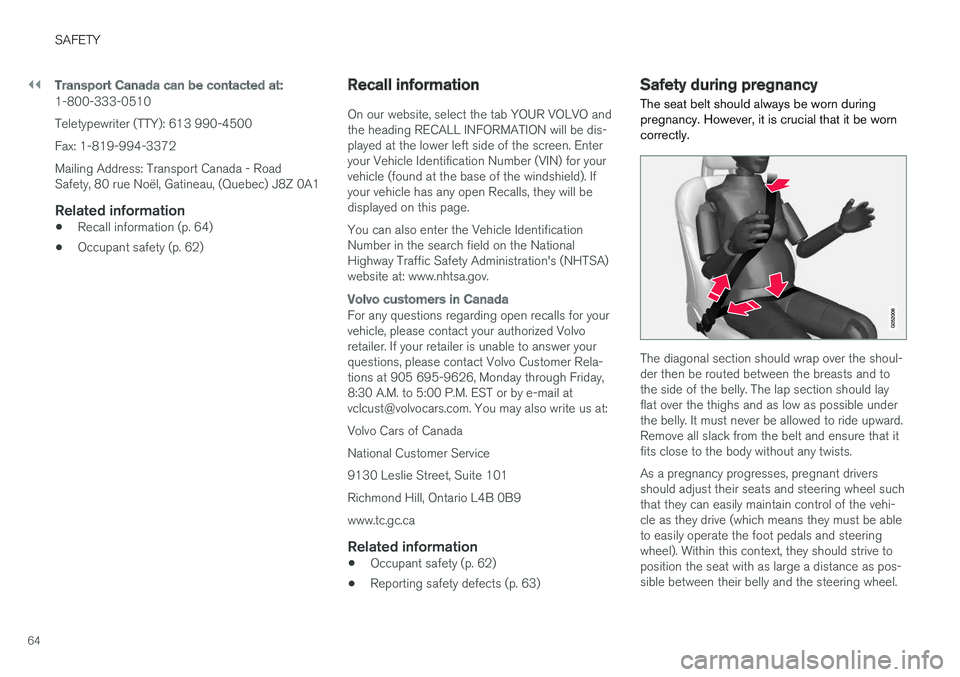
||
SAFETY
64
Transport Canada can be contacted at:
1-800-333-0510
Teletypewriter (TTY): 613 990-4500
Fax: 1-819-994-3372
Mailing Address: Transport Canada - RoadSafety, 80 rue Noël, Gatineau, (Quebec) J8Z 0A1
Related information
•Recall information (p. 64)
•Occupant safety (p. 62)
Recall information
On our website, select the tab YOUR VOLVO andthe heading RECALL INFORMATION will be dis-played at the lower left side of the screen. Enteryour Vehicle Identification Number (VIN) for yourvehicle (found at the base of the windshield). Ifyour vehicle has any open Recalls, they will bedisplayed on this page.
You can also enter the Vehicle IdentificationNumber in the search field on the NationalHighway Traffic Safety Administration's (NHTSA)website at: www.nhtsa.gov.
Volvo customers in Canada
For any questions regarding open recalls for yourvehicle, please contact your authorized Volvoretailer. If your retailer is unable to answer yourquestions, please contact Volvo Customer Rela-tions at 905 695-9626, Monday through Friday,8:30 A.M. to 5:00 P.M. EST or by e-mail [email protected]. You may also write us at:
Volvo Cars of Canada
National Customer Service
9130 Leslie Street, Suite 101
Richmond Hill, Ontario L4B 0B9
www.tc.gc.ca
Related information
•Occupant safety (p. 62)
•Reporting safety defects (p. 63)
Safety during pregnancy
The seat belt should always be worn duringpregnancy. However, it is crucial that it be worncorrectly.
The diagonal section should wrap over the shoul-der then be routed between the breasts and tothe side of the belly. The lap section should layflat over the thighs and as low as possible underthe belly. It must never be allowed to ride upward.Remove all slack from the belt and ensure that itfits close to the body without any twists.
As a pregnancy progresses, pregnant driversshould adjust their seats and steering wheel suchthat they can easily maintain control of the vehi-cle as they drive (which means they must be ableto easily operate the foot pedals and steeringwheel). Within this context, they should strive toposition the seat with as large a distance as pos-sible between their belly and the steering wheel.